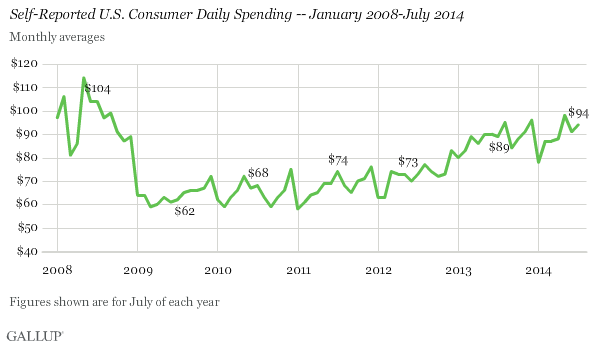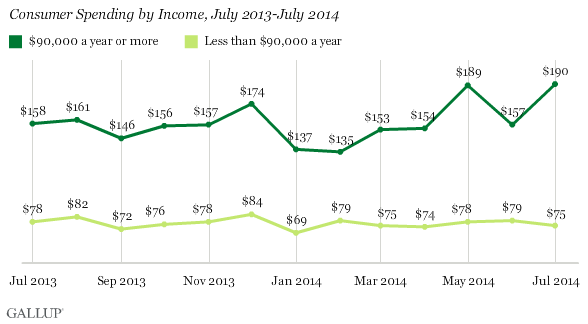WASHINGTON, D.C. -- Americans' self-reports of daily spending averaged $94 in July, up slightly from the $91 they reported in June, but below the $98 in May. Average spending in July 2014 was higher than the $89 average in July 2013.

These figures are based on Gallup Daily tracking interviews with more than 15,000 Americans throughout July. The poll asks Americans to report the total amount they spent "yesterday" in stores, gas stations, restaurants, or online -- not counting home and vehicle purchases, or normal monthly bills -- and gives an indication of discretionary spending.
Reports of daily spending continue to exceed those in the $60 to $70 range that Gallup measured during the waning months of the recession and its aftermath, but are still below the $100 averages seen several times in 2008 before the financial crisis. Spending approached this level in May of this year at $98, a monthly figure not seen since September 2008. The improvement last month after spending dropped in June, as well as the longer-term recovery in spending over the last two years, are positive signs because consumer spending is a major fuel for the U.S. economy.
Spending Rebounds Among Higher-Earning Americans
Spending reports increased to an average of $190 per day among Americans who make $90,000 or more a year. July showed substantial improvement among this group over June's $157 average, and this accounts for the increase in average consumer spending among all Americans. Spending among middle- and lower-income Americans -- the bulk of U.S. consumers -- dropped slightly to $75 per day.

The dip in overall spending Gallup found in June was the result of a decline among upper-income Americans. Spending among middle- and lower-income Americans has largely been consistent since February.
Implications
Consumer spending is important to the U.S. economy -- in fact, personal consumption involves about 70% of U.S. economic output. It also represents a large portion of the U.S. gross domestic product, which, according to the government's preliminary estimate, grew at a healthy 4.0% annual rate in the second quarter of this year. Although there have been some small changes in the month-to-month averages reported by Gallup, the broader trend since early 2012 has been one of increasing consumer spending, which could help fuel economic recovery.
Gallup.com reports results from these indexes in daily, weekly, and monthly averages and in Gallup.com stories. Complete trend data are always available to view and export in the following charts:
Daily: Employment, Economic Confidence, Job Creation, Consumer Spending
Weekly: Employment, Economic Confidence, Job Creation, Consumer Spending
Read more about Gallup's economic measures.
View our economic release schedule.
Survey Methods
Results for this Gallup poll are based on telephone interviews conducted July 1-31, 2014, on the Gallup Daily tracking survey, with a random sample of 15,222 adults, aged 18 and older, living in all 50 U.S. states and the District of Columbia.
For results based on the total sample of national adults, the margin of sampling error is ±1 percentage point at the 95% confidence level. The margin of error for the spending mean is ±$5.
Interviews are conducted with respondents on landline telephones and cellular phones, with interviews conducted in Spanish for respondents who are primarily Spanish-speaking. Each sample of national adults includes a minimum quota of 50% cellphone respondents and 50% landline respondents, with additional minimum quotas by time zone within region. Landline and cellular telephone numbers are selected using random-digit-dial methods. Landline respondents are chosen at random within each household on the basis of which member had the most recent birthday.
Samples are weighted to correct for unequal selection probability, nonresponse, and double coverage of landline and cell users in the two sampling frames. They are also weighted to match the national demographics of gender, age, race, Hispanic ethnicity, education, region, population density, and phone status (cellphone only/landline only/both, and cellphone mostly). Demographic weighting targets are based on the most recent Current Population Survey figures for the aged 18 and older U.S. population. Phone status targets are based on the most recent National Health Interview Survey. Population density targets are based on the most recent U.S. census. All reported margins of sampling error include the computed design effects for weighting.
In addition to sampling error, question wording and practical difficulties in conducting surveys can introduce error or bias into the findings of public opinion polls.
For more details on Gallup's polling methodology, visit www.gallup.com.
